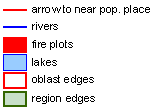Avialesookhrana
from the National Forest Fire Centre of Russia provides up-to-date NOAA images
for the whole of the Russian Federation and neighbour territories. The Space Monitoring Information Support
Laboratory provides extensive links to sites with satellite imagery for
the Russian Federation, meteorological information as well as fire related
images are accessible.
The NOAA AVHRR satellite image composite shows fire
activities in the Russian Federation.
NOAA 12 & 14 AVHRR composite of 2 August 2002.
The red squares indicate regions of active fires. For details the GFMC readers
are encouraged to
use the hyperlinks provided by Avialesookhrana, the Aerial Forest Fire
Protection Service of the
Federal Forest service of Russia.
(Source: Avialesookhrana cloudiness maps)
According
to the situation report of the Ministry of Natural Resources of 31 July 2002 a
total of 366 fires affected 4,849 ha forested and 2,448 ha non‑forested
areas. In addition 167 fires occurred that were put out the same day when they
started.
Since the beginning of the 2002 fire season for Ministry of Natural Resources
a total of 21,160 fires affected 620,773 ha forested and 325,837 ha
non‑forested land.
Highest fire activities were recorded in
Central and Northern European part of Russia in the following regions:
Moscow region-97 fires, Iaroslavl-39, Kostroma –18?Vologda –31, Nizhiy
Novgorod –23,
Komi-17, Arkhangelsk-22. There are lot of peat fires in East of Moscow
region (Shatura), Vladimir region, Iaroslavl region (along the Volga river),
Kostroma region. So pretty smoke from them. Today even was cancelled the
detection flight in Moscow region for low visibility reason. For instance in
Moscow region today were involved to fire fighting 737 people and 222 engines
and dozers. But peat fires very difficult to put out. Depth of peat sometimes
get several meters and temperature in the depth get 1200-1300 degree C.
In Siberia high fire activity retain in Iakutia –55 fires and 20 of it
–large fires, the biggest is 25,000 ha. Just on 10 large fires have involved
heavy techniques, on other 10 going on just confining activity.
Through all of Russia on fire fighting have been involved 5,485 people, 53
aircraft, 915 bulldozers, tractors and engines.
Source: Aerial Forest Fire Protection Service of Russia (Avialesookhrana)
Operational
Significant Event Imagery (OSEI)
The following significant event was identified by Satellite Analysis
Branch meteorologists and reviewed by the OSEI support team of the
National Oceanic and Atmospheric Administration (NOAA):
FIRES BURNING IN RUSSIA
MODIS satellite imagery showing fires in Russia 07/31/2002 09:00 UTC
Heat signatures (red) and smoke plumes (light blue haze) are visible.
(Source: OSEI/NOAA)
UPDATE - Forest fires blanket
Moscow in smog
Source: ABC News, 31 July 2002
"Muscovites awoke on Wednesday to find their city covered in smog with the smell of burning from wildfires raging outside the Russian capital.
A slight easterly wind pushed the smoke toward the city, as far as the centre, but was not strong enough
to disperse it, said meteorological experts quoted by Moscow Echo radio. Moscow media said the smoke posed a health risk to residents of the city.
The authorities have identified 76 separate wildfires in the Moscow region, which has been affected for
several weeks by a heatwave, Moscow Echo radio reported.
According to the emergencies ministry, the surface area of forest on fire around Moscow has risen
sharply in the past 24 hours, reaching 260 acres, ITAR-TASS reported. Helicopters have joined in efforts to put out the forest fires, of which the two most severe are the Shatura
region, east of Moscow.Forest fires blanket Moscow in smog."
Latest Satelite Image:
Thick smoke blankets over Moscow.
Source: MODIS
Eurasian Experimental Fire Weather
Information System
The system has been developed by forest fire researchers from Canada, Russia and Germany
is displayed on this website starting 18 July 2001. Complete information and a set of
daily fire weather and fire behaviour potential maps covering Eurasia (the Baltic Region,
Eastern Europe, countries of the Commonwealth of Independent States, Mongolia) can be
accessed at:
http://www.uni-freiburg.de/fireglobe/fwf/eurasia.htm
Example of the Eurasian
Experimental Fire Weather Information System:
The Experimental Fire Weather Index (FWI) for Russia and neighbouring
countries, 2 August 2002.
Daily Fire Occurrence and Fire Danger Maps of the Fire Laboratory
of the Sukachev Institute of Forest, Krasnoyarsk
Selected fire occurrence maps, satellite images and a forest fire danger map are prepared
daily by the Russian GFMC correspondent Dr. Anatoly Sukhinin, Fire Laboratory of the
Sukachev Institute of Forest, Krasnoyarsk, in collaboration with the
Emergency Situation Monitoring and Forecasting Agency, Krasnoyarsk branch. The maps
are produced on the base of satellite data (classification by the NOAA AVHRR). They show
the fire locations (by latitude and longitude) and the area affected by fire (red
signature, size in ha). The red arrow at each fire location points to the nearest
populated place. The terms Oblast or Krai used in the maps are
designations of administrative regions. A map showing the boundaries of
administrative regions and a legend is included below.
Overview map showing large fire locations covering the 10-days period 22 July to 1 August 2002:
Selected maps showing fire activities on 1 August 2002:
For more details on fire in the Russian Federation, Mongolia and China: See IFFN Country Notes. Scientific details on fire in the Russian Federation are provided by the Fire Research Campaign Asia-North (FIRESCAN) report.
Bibliography on fire in ecosystems of boreal Eurasia:
One of the results of the first international fire science conference in the
Russian Federation (1993) was the publication of a monograph on fire in boreal Eurasia,
including some selected contributions on boreal North America. The literature cited in the
monograph contains numerous publications which in many cases are not easily accessible. To
facilitate literature search the bibliographical sources are provided by topic (chapter).
Goldammer, J.G. and V.V.Furyaev. 1996. Fire
in Ecosystems of Boreal Eurasia. Kluwer Academic Publishers, Dordrecht, 390 p.















